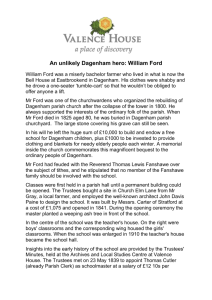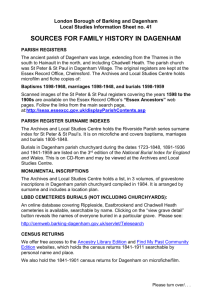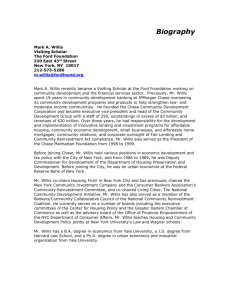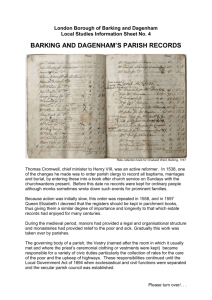“MADE IN DAGENHAM”
advertisement
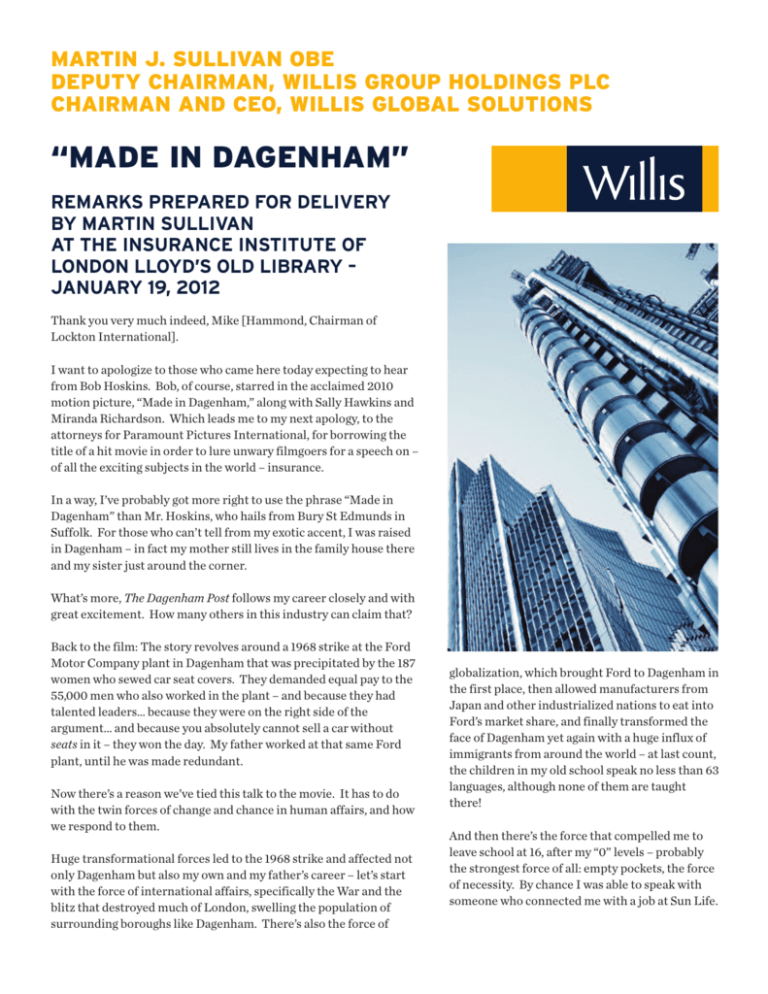
MARTIN J. SULLIVAN OBE DEPUTY CHAIRMAN, WILLIS GROUP HOLDINGS PLC CHAIRMAN AND CEO, WILLIS GLOBAL SOLUTIONS “MADE IN DAGENHAM” REMARKS PREPARED FOR DELIVERY BY MARTIN SULLIVAN AT THE INSURANCE INSTITUTE OF LONDON LLOYD’S OLD LIBRARY – JANUARY 19, 2012 Thank you very much indeed, Mike [Hammond, Chairman of Lockton International]. I want to apologize to those who came here today expecting to hear from Bob Hoskins. Bob, of course, starred in the acclaimed 2010 motion picture, “Made in Dagenham,” along with Sally Hawkins and Miranda Richardson. Which leads me to my next apology, to the attorneys for Paramount Pictures International, for borrowing the title of a hit movie in order to lure unwary filmgoers for a speech on – of all the exciting subjects in the world – insurance. In a way, I’ve probably got more right to use the phrase “Made in Dagenham” than Mr. Hoskins, who hails from Bury St Edmunds in Suffolk. For those who can’t tell from my exotic accent, I was raised in Dagenham – in fact my mother still lives in the family house there and my sister just around the corner. What’s more, The Dagenham Post follows my career closely and with great excitement. How many others in this industry can claim that? Back to the film: The story revolves around a 1968 strike at the Ford Motor Company plant in Dagenham that was precipitated by the 187 women who sewed car seat covers. They demanded equal pay to the 55,000 men who also worked in the plant – and because they had talented leaders… because they were on the right side of the argument… and because you absolutely cannot sell a car without seats in it – they won the day. My father worked at that same Ford plant, until he was made redundant. Now there’s a reason we’ve tied this talk to the movie. It has to do with the twin forces of change and chance in human affairs, and how we respond to them. Huge transformational forces led to the 1968 strike and affected not only Dagenham but also my own and my father’s career – let’s start with the force of international affairs, specifically the War and the blitz that destroyed much of London, swelling the population of surrounding boroughs like Dagenham. There’s also the force of globalization, which brought Ford to Dagenham in the first place, then allowed manufacturers from Japan and other industrialized nations to eat into Ford’s market share, and finally transformed the face of Dagenham yet again with a huge influx of immigrants from around the world – at last count, the children in my old school speak no less than 63 languages, although none of them are taught there! And then there’s the force that compelled me to leave school at 16, after my “0” levels – probably the strongest force of all: empty pockets, the force of necessity. By chance I was able to speak with someone who connected me with a job at Sun Life. A year later, a couple of things happened in succession: I heard of a job in Bermuda with AIUO, the international business of AIG, and I sent in my resume, not quite realizing that it was a CFO position that at 16 I was nowhere near qualified for. But for whatever reason, the executive who received my CV did not throw it in the garbage – he saw some kind of potential and took a chance and hired me as an accounts clerk at a salary of £100 more than I was making at Sun Life. So at £850 a year, I clearly joined AIG for the money. But the next step didn’t come soon enough, and I was about to leave AIG to head up the local betting office, when our CFO – a guy by the name of Paul Acratopulo – took me for a walk in Croydon cemetery and told me that if I stayed with AIG, I would make more money than all my friends put together. For some reason I can’t quite put my finger on, that argument won the day. Actually, there was a whole host of reasons why I listened to him – and 35 years later, instead of running the Dagenham betting shop, or maybe even a chain of betting offices, I had risen through the ranks at AIG and was doing things like introducing President Hu Jintao at the APEC summit in Vietnam and participating in meetings at the White House. Hard to believe! It’s really all about change and chance, and how we respond to it. Or, as John Lennon famously put it, “Life is what happens to you while you’re busy making other plans.” Which, strangely enough, is also what insurance is about, isn’t it? In the course of 40-some-odd years, I’ve seen change and chance affect the insurance industry in ways I could never have predicted. Why, the very definition of risk has changed. When I joined AIG in 1971, you looked up the tariff in a book, you got the rate, and you generated the premium – simple as that. Suddenly in the late seventies, tariffs went out of favor, and we all became experts – and we have hardly made an underwriting profit since. What a wonderful job we’ve done. I’m serious – there have been only four years since 1978 in which underwriters achieved a combined ratio of under 100%. Any profits made in the other 30 years were generated by investments. Well I submit to you that, not being in the banking or private equity industries, our core skill is not making investment income. If all you want is investment income, you might as well just put the underwriting pen back in the drawer! And now I’m on the other side of the fence, so to speak. For me, the shift from insurer to broker has been an eye-opener. This job is even harder! If you are one of our major insurance carrier clients and you manage your distribution channels, you turn up at work in the morning and expect a flow of business to deal with every day. But when you’re a broker, you have to make it happen. I like to say you quickly reach 250% capacity – you spend 50% prospecting, 50% defending, and 150% advising your clients every day. You simply have to make it happen every day. As brokers, we have to look at the business segment by segment. This is no longer a transactionled business. The transaction is an integral part of the picture, but it’s only one small part. If you are looking at larger global accounts then you have to add meaningful value as an adviser. This is done through deep analysis of the multiplicity of risks and the search for best solutions, whether that be risk transfer, or management, or avoidance. Many clients are more interested in what 2 Willis • January 19, 2012 you are doing for the eleven months of the year you are not handling the transaction. Not that price isn’t important – of course it is. Insurance buyers will always be concerned about cost, especially in tough economic times. “But,” if I may quote Reactions magazine, “it is a fact that most insurance buyers with larger national and multinational companies clearly state, on and off the record, that the quality and reliability of the coverage and ability of brokers and insurers to deliver sophisticated and bespoke solutions to their specific needs is more important than the price.” Another area in which the business is changing may seem obvious, but I can assure you it wasn’t always so: It is listening to our clients. Years ago we used to design a product and say: ‘Here, you need this’ and the client would say: ‘No we don’t.’ We’d then say, ‘What do you mean you don’t need it, here it is, you’ve got to buy it.’ Today we are listening more to our clients… responding to their concerns… and trying to develop the products they need. Of course, the answer is not always going to be a product. More and more, it’s going to be risk management or even risk elimination. So the answer is to listen, and deliver solutions, and be appropriately compensated for the value those solutions add, or the risk they mitigate. And because, in our time, new risks are emerging at an alarmingly fast rate, the industry needs to innovate in order to develop these solutions. Unfortunately, our industry is not known for innovation or speed to market of new products. We can in fact be cautious to a fault. Caution, I would argue, is a virtue in insurance – but as Aristotle once said, “Too much of a virtue can be a vice.” In my opinion, the last really new product we introduced was directors’ and officers’ liability. I might be persuaded to include environmental coverage, though in truth I think that flatters to deceive. These innovations were in most cases triggered by changes in the legal system decades ago, starting in the U.S. and exported the world over. I believe we’re on the verge of another wave of innovation, in this case driven not only by changing laws around the world but also by the emergence of new kinds of risks for which existing insurance and risk management techniques are inadequate. If you’d asked me 20 years ago if a volcanic eruption in Iceland could disrupt cargo transportation and passenger flows around the world I would have said it’s made in the Willis • January 19, 2012 3 movies, that’s never going to happen. Well, it happened. Similarly having two massive tsunamis costing a quarter of a million lives in the span of one decade. You would have said that’s not very likely – it happened. In fact disaster losses in 2011 set a record for economic losses at $380 billion and were the second-highest for insured losses at $105 billion. It’s not just the pattern of natural disasters that’s changing. My job is to look after the needs of some of the world’s largest companies, talk to them about the challenges they face, and offer solutions that are comprehensive and global. It doesn’t take too many of those conversations to realize that business leaders throughout the world are worried about similar issues – especially about very new risks that have emerged in recent years… risks for which there may not even be complete solutions yet. Let me just say a word or two about the four risks that come up most often in these conversations, and then I’ll be happy to take your questions: The first is brand and reputation. When one thinks of Disney, or Coca-Cola, or McDonald’s – the brands of these great companies are their reputations. We only need to look at BP and Toyota as recent examples of great corporations that faced a crisis and are working very hard to restore their reputations. It is critical to understand that this kind of event – a corporate reputation catastrophe – is not rare. We think of “one-in-200-year” events as the frequency benchmark for natural catastrophes – major earthquakes, cyclones, great floods and the like. But corporate catastrophes among the world’s leading companies happen about once a decade. The second emerging risk is cyber security. The business leaders I speak with are focused on two new cyber risks in particular: One is cloud computing. The nature of the cloud is such that customers have less control over, or knowledge of, the exact location of the resources and the information held. Using the cloud by definition relinquishes some control over data. The other cyber risk is social media. For corporate leaders, the aggregation of so much information represents a significant risk of defamation, breach of privacy, reputational risk, and even regulatory risk for violations of disclosure laws. The third risk is patent infringement, also referred to as intellectual property – one of the largest risk exposures across all business sectors, but especially the biomedical and biotech industries, which hold so much promise for improving the quality of life in the decades ahead. Fortunately, the insurance industry has developed products to help organizations identify intellectual property risks and understand the degree and kind of litigation taking place within a given business sector. In our case, Willis created a software product called PatentWize, to help manage the risk. There are two key reasons for this shift to information solutions beyond traditional insurance: First, the capacity for intellectual property insurance is limited and the coverages available are restricted due to reinsurance and past losses. Second, some organizations guard their intellectual property so jealously that they will not transfer their risk to insurers for fear of information being disseminated into the markets. By adopting products like PatentWize, companies with intellectual property concerns can begin to measure their own overall exposure and work with insurers to structure a number of solutions. The fourth and final risk I’ll mention is supply chain disruption. It’s been very much in the news in the last few years for several reasons, from the recession that began in 2008 and put many suppliers out of business… to the volcanic eruption in Iceland that interrupted transatlantic air cargo over a period of six weeks... to the earthquake and tsunami in Japan, whose knock-on effects on supply chains are still playing out… and more recently, the Thai floods. A McKinsey survey last year found that nearly 70% of senior executives from major global companies believe that supply chain risk will increase in the next five years. Many list it among their top five corporate exposures. In some cases, this risk is a direct consequence of the drive for “just-in-time” inventory. By improving risk assessment, one can identify the key suppliers and better understand the financial exposure. This then supports taking the most promising strategy, whether buffering stock levels… buying out financially fragile suppliers… dual sourcing… or developing risk transfer solutions. I hope these four examples help illustrate how the world has changed and the risk environment with it. I’ve tried to show a few of the ways insurers and brokers are changing, too. We’ve come a long way from Dagenham, haven’t we? But the point I make applies to London and New York in 2012 as much as it did to Dagenham in 1968: Yes, we need to have a vision of the future and to make plans for our lives, our families, our companies, and our careers. But no matter what plans we make, there is a limit to what we can know and predict, and so we also need to maintain a sense of humility, and a healthy respect for the role of change and chance in all human affairs – and be prepared to respond to whatever challenge or opportunity life may throw our way. Thank you very much. Willis Group Holdings plc is a leading global insurance broker. Through its subsidiaries, Willis develops and delivers professional insurance, reinsurance, risk management, financial and human resource consulting and actuarial services to corporations, public entities and institutions around the world. Willis has more than 400 offices in nearly 120 countries, with a global team of approximately 17,000 Associates serving clients in virtually every part of the world. Additional information on Willis may be found at www.willis.com. 4 Willis • January 19, 2012


